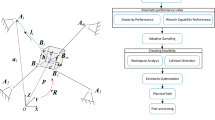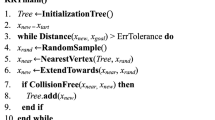Abstract
Path planning of cable-driven parallel robots (CDPRs) is a challenging task due to cables which may cause various collisions. In this paper, three steps are suggested to perform path finding of CDPRs in cluttered environments. First, a way to visualize the cable collision of CDPRs is suggested to consider actual workspace of CDPRs. Second, a path finding algorithm based on rapidly exploring random trees (RRT) is presented to find a path free of various collisions of CDPRs including cable collisions and wrench feasible workspace. While conventional RRT algorithms are mainly focused on mazy environments, the modified RRT algorithm proposed here directly connects a sampled node and the tree to find a path faster in a non-mazy, but cluttered environment. Goal-biased sampling algorithm is also modified and employed to decrease computational cost. To deal with complicated collision detection of cables in the RRT, Gilbert–Johnson–Keerthi algorithm was employed. Finally, post-processing algorithm for any waypoint-based path is suggested to get a shorter and less winding path. A numerical study was carried out to suggest choosing proper meta parameters for the post-processing algorithm. The suggested algorithms were evaluated with 1000 times of simulations, and they were equally carried out for RRT* to compare. According to the results, the suggested algorithm found a shorter path with less computation time compared to RRT* and the post-processing algorithms made the already found path shorter.









Similar content being viewed by others
References
Sohrabi S, Daniali HM, Fathi A (2016) Trajectory path planning of cable driven parallel manipulators, considering masses and flexibility of the cables. Int J Adv Des Manuf Technol 9(3):57–64
Pott A, Mütherich H, Kraus W, Schmidt V, Miermeister P, Verl A (2013) Ipanema: a family of cable-driven parallel robots for industrial applications. In: Cable-Driven Parallel Robots. Springer, pp 119–134
Gagliardini L, Caro S, Gouttefarde M, Wenger P, Girin A (2015) A reconfigurable cable-driven parallel robot for sandblasting and painting of large structures. In: Cable-Driven Parallel Robots. Springer, pp 275–291
Merlet JP (2017) Preliminaries of a new approach for the direct kinematics of suspended cable-driven parallel robot with deformable cables. In: New trends in mechanism and machine science. Springer, pp 355–362
Berti A, Merlet JP, Carricato M (2016) Solving the direct geometrico-static problem of underconstrained cable-driven parallel robots by interval analysis. Int J Robot Res 35(6):723–739
Mandava RK, Katla M, Vundavilli PR (2018) Application of hybrid fast marching method to determine the real-time path for the biped robot. Intell Serv Robot 12:1–12
Orozco-Rosas U, Montiel O, Sepúlveda R (2019) Mobile robot path planning using membrane evolutionary artificial potential field. Appl Soft Comput 77:236–251
Thabit S, Mohades A (2019) Multi-robot path planning based on multi-objective particle swarm optimization. IEEE Access 7:2138–2147
Taoudi A, Luo C (2019) Obstacle avoidance for a quadrotor using A* path planning and LQR-based trajectory tracking. In: AIAA Scitech 2019 Forum, p 1566
Nguyen DQ, Gouttefarde M (2015) On the improvement of cable collision detection algorithms. In: Cable-driven parallel robots. Springer, pp 29–40
Blanchet L, Merlet JP (2014) Interference detection for cable-driven parallel robots (CDPRs). In: 2014 IEEE/ASME international conference on advanced intelligent mechatronics (AIM). IEEE, pp 1413–1418
Wang B, Zi B, Qian S, Zhang D (2016) Collision free force closure workspace determination of reconfigurable planar cable driven parallel robot. In: Asia-Pacific conference on intelligent robot systems (ACIRS). IEEE, pp 26–30
Lahouar S, Ottaviano E, Zeghoul S, Romdhane L, Ceccarelli M (2009) Collision free path-planning for cable-driven parallel robots. Robot Auton Syst 57(11):1083–1093
LaValle SM (1998) Rapidly-exploring random trees: a new tool for path planning. Computer Science Dept Oct
LaValle SM, Kuffner JJ Jr (2000) Rapidly-exploring random trees: progress and prospects. In: Algorithmic and computational robotics: new directions. Citeseer
Dong Y, Fu C, Kayacan E (2016) RRT-based 3D path planning for formation landing of quadrotor UAVs. In: 14th international conference on control, automation, robotics and vision (ICARCV). IEEE, pp 1–6
Peng XZ, Lin HY, Dai JM (2016) Path planning and obstacle avoidance for vision guided quadrotor UAV navigation. In: 12th IEEE international conference on control and automation (ICCA). IEEE, pp 984–989
Lu L, Zong C, Lei X, Chen B, Zhao P (2017) Fixed-wing UAV path planning in a dynamic environment via dynamic RRT algorithm. In: Mechanism and machine science: Proceedings of ASIAN MMS 2016 & CCMMS 2016. Springer, pp 271–282
Palmieri L, Arras KO (2014) A novel RRT extend function for efficient and smooth mobile robot motion planning. In: IEEE/RSJ international conference on intelligent robots and systems (IROS 2014). IEEE, pp 205–211
Kamarry S, Molina L, Carvalho EÁN, Freire EO (2015) Compact RRT: a new approach for guided sampling applied to environment representation and path planning in mobile robotics. In: 12th Latin American Robotics Symposium (LARS) and 3rd Brazilian Symposium on Robotics (LARS-SBR). IEEE, pp 259–264
Moon C, Chung W (2016) Practical probabilistic trajectory planning scheme based on the rapidly-exploring random trees for two-wheeled mobile robots. Int J Precis Eng Manuf 17(5):591–596
Lan X, Di Cairano S (2015) Continuous curvature path planning for semi-autonomous vehicle maneuvers using RRT. In: European Control Conference (ECC). IEEE, pp 2360–2365
Kuwata Y, Fiore GA, Teo J, Frazzoli E, How JP (2008) Motion planning for urban driving using RRT. In: IEEE/RSJ international conference on intelligent robots and systems. IEEE, pp 1681–1686
Noreen I, Khan A, Ryu H, Doh NL, Habib Z (2018) Optimal path planning in cluttered environment using RRT*-AB. Intell Serv Robot 11(1):41–52
Gammell JD, Srinivasa SS, Barfoot TD (2014) Informed RRT*: optimal sampling-based path planning focused via direct sampling of an admissible ellipsoidal heuristic. In: 2014 IEEE/RSJ international conference on intelligent robots and systems (IROS 2014). IEEE, pp 2997–3004
Ericson C (2004) Real-time collision detection. CRC Press, Boca Raton
Bergen G (1997) Efficient collision detection of complex deformable models using AABB trees. J Graph Tools 2(4):1–13
Klosowski JT, Held M, Mitchell JS, Sowizral H, Zikan K (1998) Efficient collision detection using bounding volume hierarchies of k-dops. IEEE Trans Vis Comput Graph 4(1):21–36
Gottschalk S, Lin MC, Manocha D (1996) Obbtree: a hierarchical structure for rapid interference detection. In: Proceedings of the 23rd annual conference on Computer graphics and interactive techniques. ACM, pp 171–180
Gilbert EG, Johnson DW, Keerthi SS (1988) A fast procedure for computing the distance between complex objects in three-dimensional space. IEEE J Robot Autom 4(2):193–203
Dyllong E, Luther W (2004) The GJK distance algorithm: an interval version for incremental motions. Numer Algorithms 37(1–4):127–136
XueMei J (2015) Rapidly-exploring random tree (RRT)-based path planning for cable-driven parallel robot considering interference between cables and platform. Ph.D. thesis, Chonnam University, Gwangju, Korea
Bergen GV (1999) A fast and robust GJK implementation for collision detection of convex objects. J Graph Tools 4(2):7–25
Karaman S, Frazzoli E (2011) Sampling-based algorithms for optimal motion planning. Int J Robot Res 30(7):846–894
Ericson C (2004) The Gilbert-Johnson-Keerthi (GJK) algorithm. SIGGRAPH Presentation
Makino T, Harada T (2016) Cable collision avoidance of a pulley embedded cable-driven parallel robot by kinematic redundancy. In: Proceedings of the 4th international conference on control, mechatronics and automation. ACM, pp 117–120
Ebert-Uphoff I, Voglewede PA (2004) On the connections between cable-driven robots, parallel manipulators and grasping. In: 2004 IEEE international conference on robotics and automation (ICRA 2004), vol 5. IEEE, pp 4521–4526
Bosscher P, Riechel AT, Ebert-Uphoff I (2006) Wrench-feasible workspace generation for cable-driven robots. IEEE Trans Robot 22(5):890–902
Hwang SW, Bak JH, Yoon J, Park JH, Park JO (2016) Trajectory generation to suppress oscillations in under-constrained cable-driven parallel robots. J Mech Sci Technol 30(12):5689–5697
Urmson C, Simmons R (2003) Approaches for heuristically biasing RRT growth. In: 2003 IEEE/RSJ international conference on intelligent robots and systems (IROS 2003), vol 2. IEEE, pp 1178–1183
Author information
Authors and Affiliations
Corresponding author
Additional information
Publisher's Note
Springer Nature remains neutral with regard to jurisdictional claims in published maps and institutional affiliations.
This research was supported by Leading Foreign Research Institute Recruitment Program through the National Research Foundation of Korea (NRF) funded by the Ministry of Science, ICT and Future Planning (MSIP) (No. 2012K1A4A3026740).
Rights and permissions
About this article
Cite this article
Bak, JH., Hwang, S.W., Yoon, J. et al. Collision-free path planning of cable-driven parallel robots in cluttered environments. Intel Serv Robotics 12, 243–253 (2019). https://doi.org/10.1007/s11370-019-00278-7
Received:
Accepted:
Published:
Issue Date:
DOI: https://doi.org/10.1007/s11370-019-00278-7




